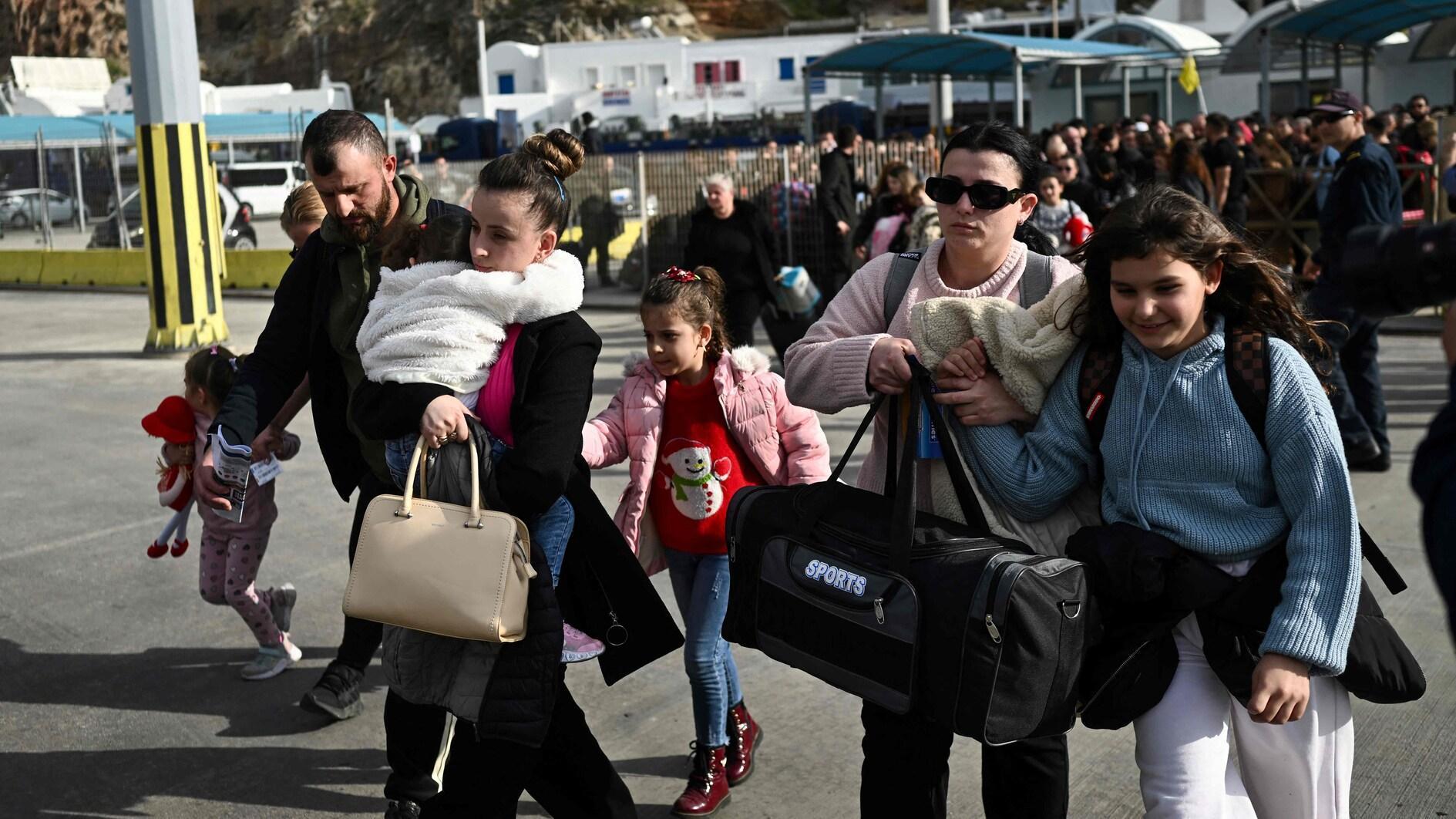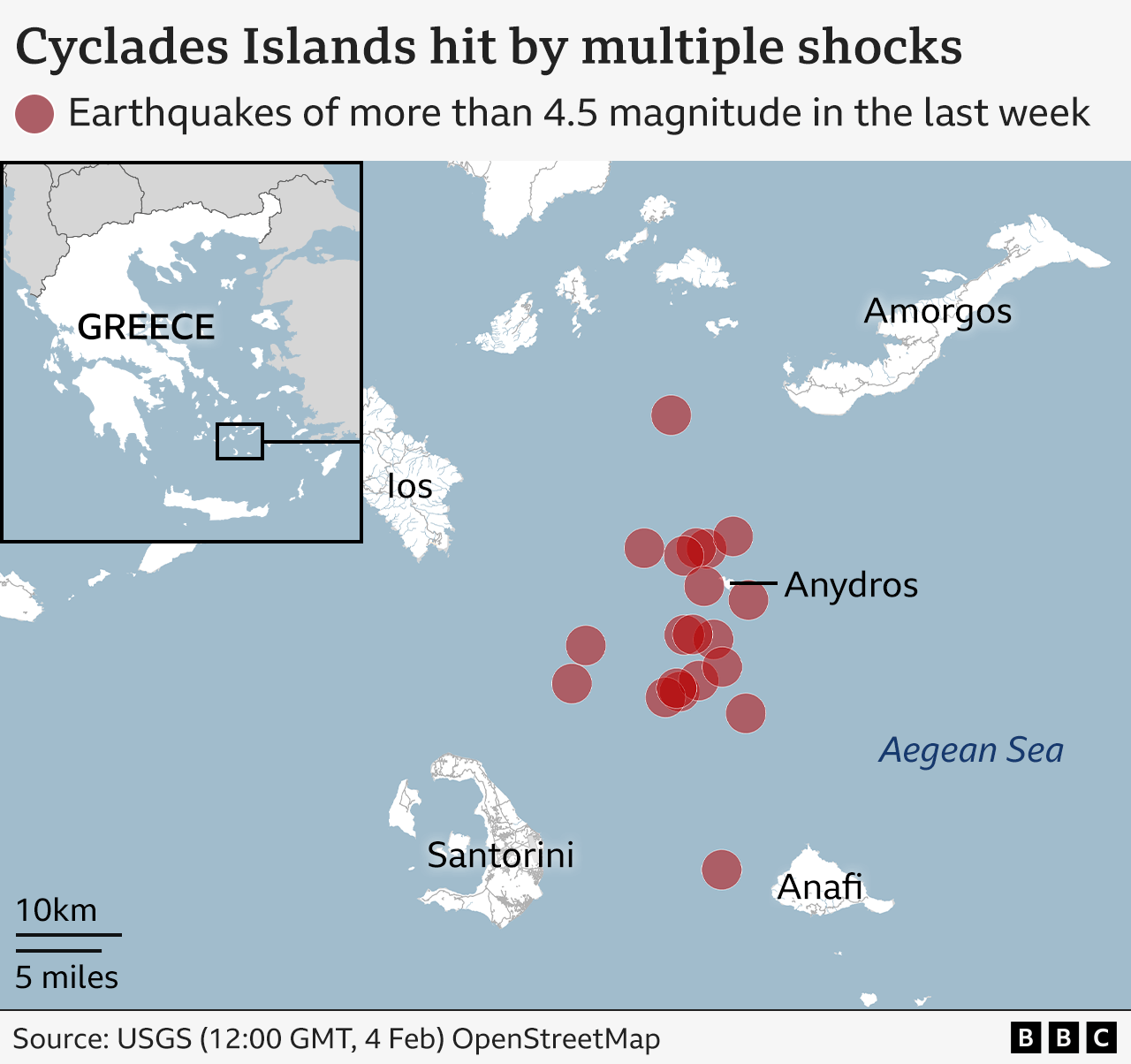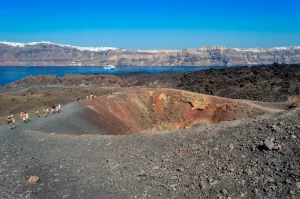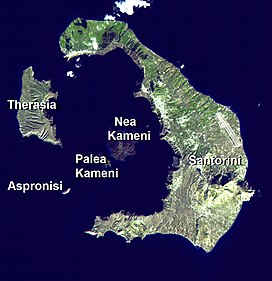Thursday 6th February. Thousands of residents are fleeing Santorini after hundreds of earthquakes have been recorded recently near the Greek island.

Today a state of emergency has been declared on the Greek island of Santorini, after days of consecutive earthquakes.
It comes after a magnitude 5.2 tremor was recorded at 21:09 local time (19:09 GMT) yesterday (Wednesday 5th February) between the Greek islands of Amorgos and Santorini, making it the strongest in recent days. It is estimated to have occurred at a depth of 5km.
The state of emergency will be in effect until 3 March to “address the emergency needs and manage the consequences”, officials said.
More than 11,000 people have already left Santorini, with around 7,000 departing by ferry and 4,000 people by air.
Authorities have closed schools and warned against large indoor gatherings, but Prime Minister Kyriakos Mitsotakis has urged calm.
The earthquake epicentres are primarily in a growing cluster between the islands of Santorini, Anafi, Amorgos, Ios and the uninhabited islet of Anydros (see map below).
Santorini is a popular tourist destination but most of those leaving are locals, as February is outside the peak tourist season.

History of earthquakes (and volcanos) on Santorini
Earthquakes (and volcanic eruptions) are a common phenomenon in Santorini, and the island group nearby.
In fact, a devastating earthquake occurred in 1613 BC, causing a massive volcanic eruption – one of the largest in the history of Earth. It is believed that this eruption led to the extermination of the Minoan civilisation of Crete, an exemplary advanced civilisation. It may have inspired the legend of Atlantis.

Tourists can take boat trips to Nea Kameni (near to Santorini) and home to an active volcano.

The volcanic complex of Santorini is the most active part of the South Aegean Volcanic Arc, which includes the active volcanoes of Methana on the mainland of Greece, Milos, Santorini and Nisyros.

Back to 1613 BC
The shores of the Aegean Sea suffered as well from the tsunami that was created and also from the volcanic ash which, in combination with the acid rain, burned the vegetation – and some nearby islands disappeared completely.
Many multi-story buildings collapsed and some people abandoned the island immediately and never came back. The absence of valuable objects or jewelry in the excavations of Akrotiri, as well as the fact that there were no human or animal skeletons found, indicates that eventually, everybody left the island as the explosion was building up.
The volcano was swallowed by the sea and along with it, a large area of the island Stroggili, as its name used to be. Santorini, Therasia, and Aspronisi are the remnants of this big round island.
Besides the volcanic ash spreading across the planet, the explosion also provoked a serious effect on the earth’s climate – causing a profound ‘volcanic winter’ all over the world.
198 BC to the modern day
14 more eruptions have occurred between 198 BC and 1950 AD (when the last eruption was recorded).
In this period, the volcano has erupted several times but none of them have been as serious as the prehistoric one. However, they have all contributed to the present form of the island of Santorini by reshaping it continuously, and to the creation of the two residual volcanic islands, Palaia Kammeni and Nea Kammeni along with healing hot springs.
Today, Santorini has lunar landscapes, colourful volcanic cliffs, breathtaking beaches covered in all colours of volcanic sand and pebbles, and a fertile, volcanic soil. The volcano stands calmly across the sea and visitors have the chance to step on it and explore it.
Santorini earthquakes: could a major seismic event (e.g. major earthquake or volcanic eruption) occur this time?
Yes, but so far, it seems unlikely. The question is debated here: could a major seismic event happen?
Medical effects of earthquakes
Earthquakes can cause a range of medical effects, including injuries, respiratory problems and mental health issues.
- Trauma: Injuries, disability, and death from building collapse
- Respiratory problems: Inhaling dust, smoke, and other toxic gases
- Tetanus: Untreated wounds can lead to tetanus, especially in areas with poor immunisation rates.
- Secondary infections: Untreated wounds can become infected
- Pregnancy and childbirth complications: Interrupted services can increase the risk of complications
- Chronic disease complications: Interrupted treatment can increase the risk of complications (e.g. lack of access to dialysis or chemotherapy)
- Mental health issues: Anxiety and other psychological problems can develop.
- Environmental contamination: Chemical or radiological contamination can occur after industrial infrastructure is destroyed
- Infectious diseases: The spread of infectious diseases can increase, especially in areas with overcrowding
- Chronic disease management: Disruptions to chronic disease management can occur.

